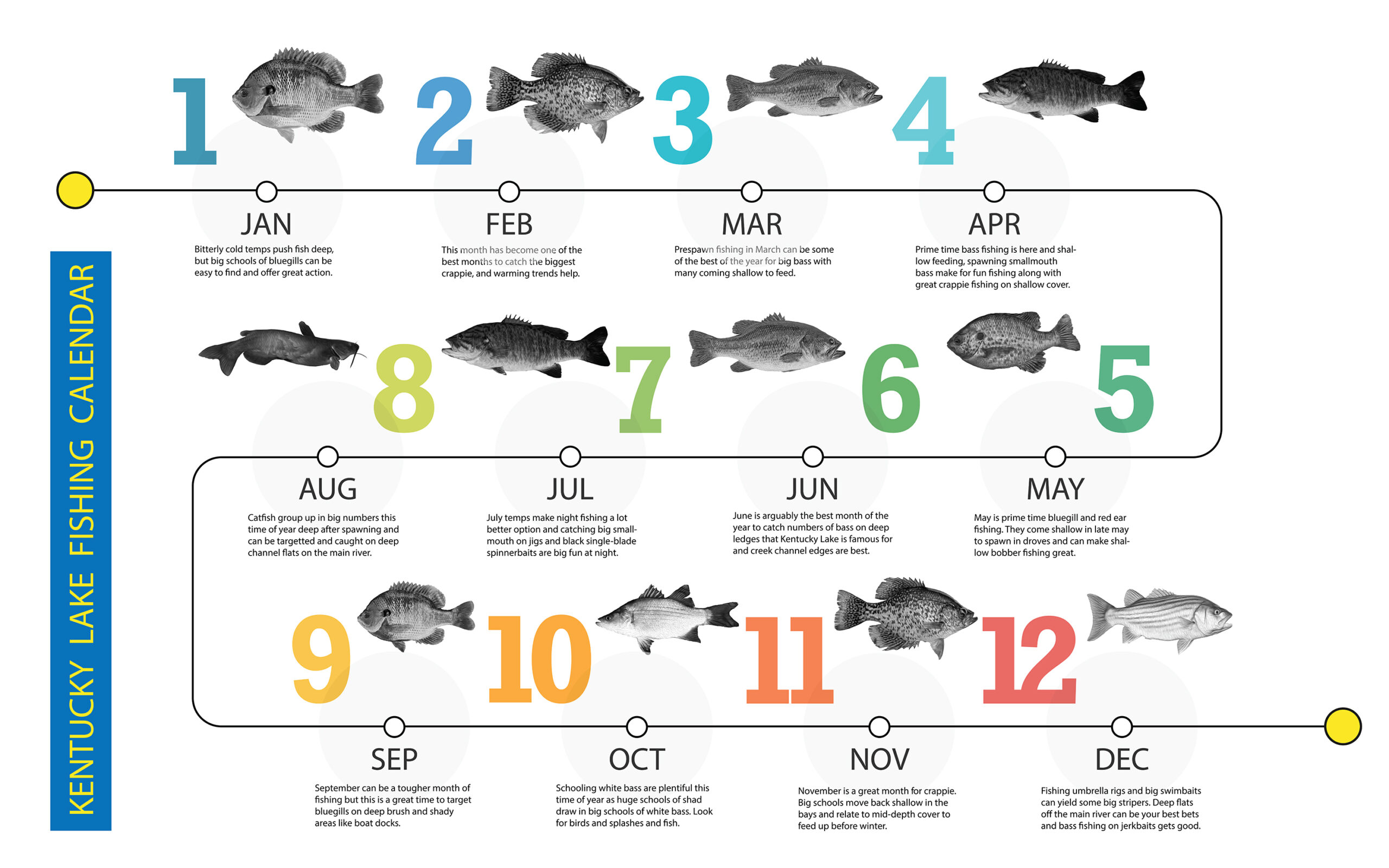Fishing Calendar
Kentucky and Barkley Lakes Annual Fishing Calendar
Kentucky Lake and Lake Barkley both offer legendarily great fishing, some of the best in the country much less the state of Kentucky. Because these fertile diverse fisheries offer so much volume, they house large populations of several of America’s favorite gamefish. Not limited to these, but fishing on Kentucky and Barkley is great for largemouth and smallmouth bass, white and black crappie, bluegill, shellcrackers, channel catfish, flathead catfish, white bass, stripers, and more.
From month to month, certain bites are better than others. So we built this calendar to help you plan your fishing trips depending on when you can make it to the lakes. We want to give you actionable intel to get you on fish and enjoy our amazing resources more fully. We want Kentucky Lake to be the place you come to make lifetime memories, and we know catching fish can help with that.
Month By Month Approach to Fishing the Lakes
So each month, anglers must factor in seasonality, natural fish migrations which generally follow water temperatures, water levels and forage movement and growth cycles regardless of the species you prefer to chase. We will offer advice on the normal fish behaviors and where to focus your efforts to hopefully shortcut your search for fish. And we’ll give you our best bets for each month if you want to chase the certain fish or plan vacations around these monthly best bites.
As is the case with fishing anywhere in the country, weather patterns change and dictate when these patterns come and go, so things may shift a week here or there depending on if you have a shorter winter or longer summer. So this is meant to be a general guide on how fish naturally progress from month to month to help you intersect with fish more consistently. No amount of advice trumps being on the water and adapting to the current conditions, so these recommendations are meant to guide more than be literal instructions at all times. Use them as a starting point and expand on them on your own, and you will greatly improve your fishing.

January Fishing
Full on winter makes for a little tougher fishing, but the fish can also be pretty predictable. Generally speaking, you find most schools of fish out deep in January.
BEST BITE: One of the best bites you can find will be giant schools of bluegill related to deep flats off the main river. You can find the schools with simple 2D sonar or side imaging fish finders. You’re just looking for lots of splotches on your screen related to the bottom in 25-40 feet of water. A short drop shot rig with red worms works, or you can use two small jigs on light 2-4 pound line. The light line will get the jigs deep faster and usually 2-pound line is plenty for bluegill fishing. However you will run into the occasional big red ear, catfish and white bass so set your drag accordingly and have a net handy.
OTHER GOOD JANUARY BITES: White bass and yellow bass also group up deep this time of year and can be caught on jigging spoons, blade baits and tail spinners. Largemouth and smallmouth bass will bite Alabama rigs with small swimbaits, jerkbaits, single swimbaits and jigs fished on deep points, humps and ledges. And I’ve found big schools of catfish deep this time of year as well in similar places.

February Fishing
February can be a great month for big fish, but you generally have to work around the last of the winter storms on the lake. We often have our coldest days in February. So be sure to layer and bundle up for fishing this month and be extra cautious and safe on below freezing days.
BEST BITE: Although the weather can be cool, this can be one of the best months to catch your biggest crappie. They will use warm days to suspend and warm their eggs to prepare for the spawn coming in the next month or two. Big crappie will suspend just under the surface over deep water sunning on the calm sunny days. It doesn’t have to be warm for them to use the sun to warm themselves.
You can catch big crappie on deep brush as well as river and creek stumps on creek channel ledges. But open water roaming crappie will fall victim to spider rigging and casting small jigs reeled extremely slow just a few feet under the surface. If warm days warm the waters quicker, crappie might get in some mid-depth cover as well. There are better months for numbers but a lot of big fish show up this time of year.
OTHER GOOD BITES: Bass fishing also starts coming out of the winter doldrums towards the end of February. Jerkbaits, swimbaits and as waters warm closer to 50 degrees the shallow and medium crankbait bite will start coming on deeper secondary points and banks and the first points going into the bays. Fishing shad kills can be dynamite fishing as can warm rains or warm waters coming from down south to get fishing moving towards the banks off the main lake.

March Fishing
Once water temps are solidly into the 50s and pushing toward the 60s, fish are moving shallow in droves. March is prime time prespawn bass fishing and they come shallow feeding heavily before the spawn. You can capitalize on this with a variety of techniques depending on water clarity.
BEST BITE: Bass fishing is in prime time swing in March and a variety of patterns work. Spinnerbaits and crankbaits if the water has some color to it. Lipless crankbaits if the water is a little clearer. Jerkbaits can still be good. Big glide baits can produce big bass this time of year. A jig is always deadly.
Fish will be on secondary banks and points and will be shallower if the water has more color and deeper if it’s clearer. There can be fish in all depths in March. Bars in the mouths of bays, humps and other high spots away from the bank can also be good. Some will be ganged up staging deeper. Some will be up shallow feeding and some will be transitioning in between. A lot of techniques work for bass in March.
OTHER GOOD BITES: March is also prime time crappie fishing. They are shallow and if the water is in the upper 50s or low 60s they are moving to spawning locations. Shallow cover and stumps are where you target if the water has warmed. If it’s still cold in the early part of the month, look for mid depth cover leading to spawning areas.

April Fishing
April is what most consider true spring fishing on the lakes. Bass, crappie, bluegills and even shellcrackers are moving shallow, spawning, preparing to spawn, just getting done spawning. But a lot of fish are on shallow banks and around shallow cover. April is also when the lake starts coming up, and with a lot of rain, there can be a lot of new fish in shallow cover if the water rises earlier than scheduled.
BEST BITE: Smallmouth bass are shallow on rocky banks, points and flats spawning and can be a lot of fun to target this month. Baits like soft jerkbaits, tubes, ned rigs and small jigs can work wonders to catch spawning smallmouth. Largemouth are also spawning in April and can be found in the bays in pockets and flats with a little depth and cover.
OTHER GOOD BITES: Crappie fishing is still dynamite in April with a lot of fish still spawning and around shallow cover guarding fry and some fish pulling back to mid depth cover. Shallow flats with brush and stumps are good bets in April as are humps with shallow cover on top. A crappie jig casted on a 1/16 ounce head and retrieved just over the top of cover is hard to beat. Or put the jig under a float and pop it along near stake beds, brush piles and stumps.
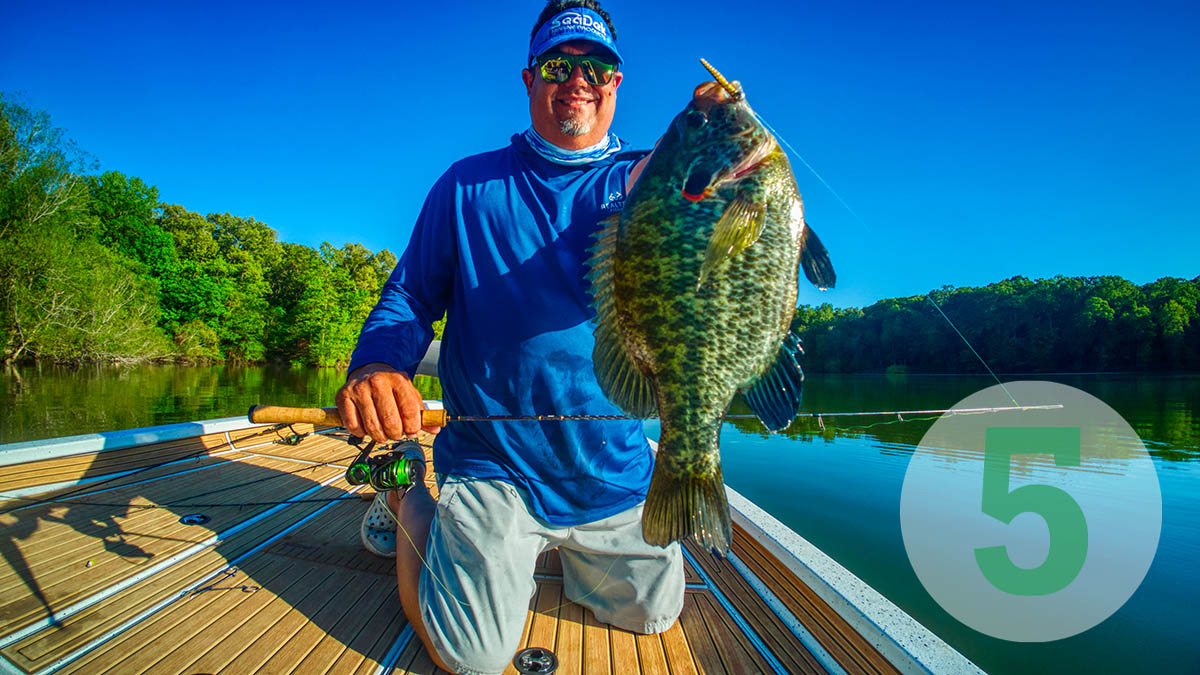
May Fishing
May is arguably the best month of the year to target bluegill and shellcrackers shallow.
BEST BITE: There will be some bedding gills and shellcrackers in early May but the biggest wave usually comes on the full moon closest to Memorial Day weekend. Both bluegills will bed from 1 foot out to 9 or 10 feet depending on the bottom composition. You can spot bluegill beds with good polarized sunglasses by going into the back of protected pockets and looking for dark spots on otherwise bright bottoms. If you notice one small area that looks a lot darker than everything around it, that is usually a bed. Red worms work, but a small bluegill spider bug or other small jig under a bobber is pretty lights out for bedding panfish shallow.
OTHER GOOD BITES: May 1 is when Kentucky and Barkley Lakes reach full summer pool and when that happens there are a lot of bushes in the water. This can be the prime window to flip bushes for largemouth bass. Look for bushes on deeper banks or where there is not a lot of water behind the bushes for bass to hide in. A Texas-rigged plastic or tube is good as is as weedless jig for flipping bushes. Use heavier fishing line and a strong rod because you may have to fight fish through a lot of limbs to get them out of cover.
There also is a good shallow topwater bite with frogs and small poppers fished around laydowns, cypress trees, bushes and under willow trees.
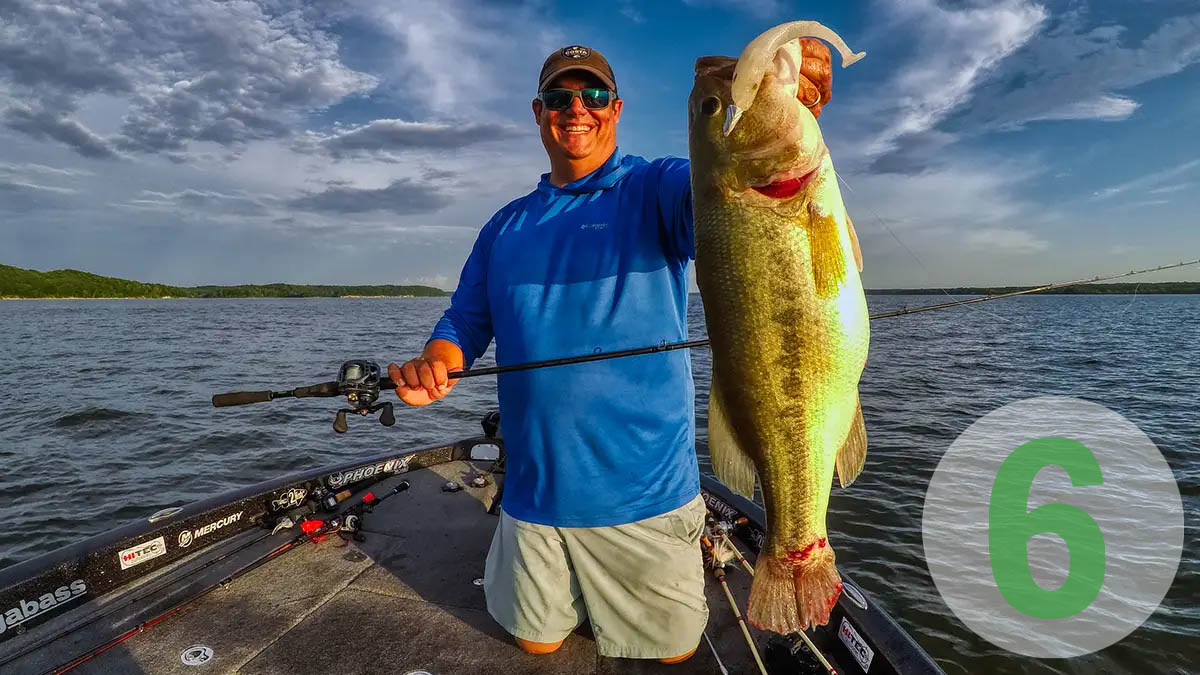
June Fishing
After most of the spawns are wrapped up the fish will migrate out to cooler deeper waters for the summer. This means it’s prime ledge season on Kentucky Lake, one of the types of fishing for which the lakes are famous.
BEST BITE: The ledges on Kentucky and Barkley Lake hold schools of bass recovering and feeding up after the spawn. Look for creek channel edges and intersections that face into the current to find schools using the current faces to ambush shad. You can study maps to look for where high spots drop off into creek and river channels and create corners that face into the current. Fish these areas by pulling your baits along the bottom on these high places. Lures like deep diving crankbaits, football jigs, big Texas rigged worms, swimbaits on jigheads all work well to catch schools of bass offshore.
OTHER GOOD BITES: Catfish are usually spawning in June. You can find a lot of fish in mid-depth to shallow areas along rocky banks, rip rap walls and near or around brush and stumps. Most catfish methods work in these areas but a lot of locals love leeches rigged under a float to catch spawning catfish. Other dead and cut bait works as well and it is possible to catch catfish on artificial like jighead minnows as well.

July Fishing
Hot temperatures can make fishing in July a little cumbersome and a lot of anglers turn to low light hours early and late and of course night fishing in July.
BEST BITE: Night fishing for smallmouth bass is another well-known local bite on the lake. Smallmouth will move into shallow areas with rocks and stumps and feed at night. They will bite black jigs and other small baits but your best bet day in and day out is a black spinnerbait with a single Colorado blade. You just make long casts and let it hit bottom and reel it slowly along the bottom. Hold on to your rod tight because the bites are startling and savage when they hit.
OTHER GOOD BITES: Catfishing continues to be hot after the spawn. Fish will move from spawning areas out to deep flats and ledges to group up.
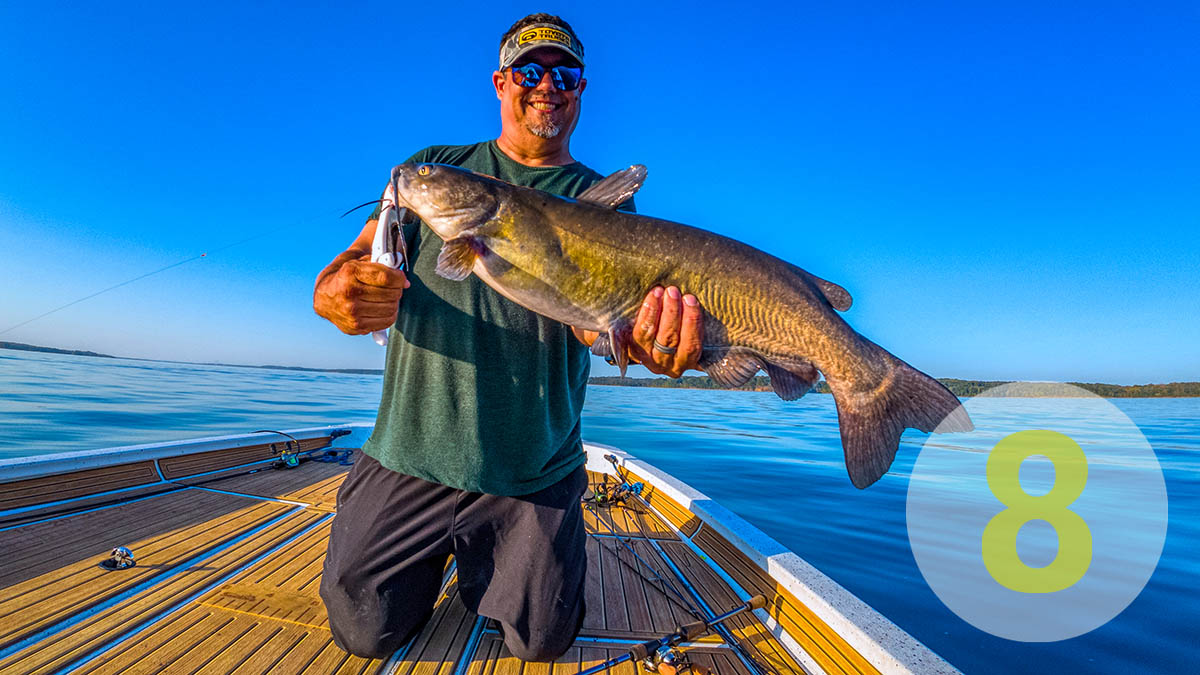
August Fishing
The summer doldrums are in full swing in August. Many fishermen curb back their fishing or fish at night but those willing to go in the hot weather will still find good bites.
BEST BITE: The schools of catfish in August are generally some of the biggest you will find all year and can be pretty easy to spot on your fish finder out deep on deep flats, ledges and humps. Current makes these fish group and feed more but they can still be caught even with low flows and lack of rain.
OTHER GOOD BITES: The bass start roaming more and moving back shallow. You will start finding topwater bites in August on shallow flats and bars in the main river and in the mouths of bays in August. Low light days will extend this bite a lot but it’s not uncommon to catch several big ones on the flat calm, hottest days of August.

September Fishing
September can be one of the tougher months of the year for fishing. The lake is dropping rapidly and falling water on the lakes tends to scatter fish and change their mood daily. They can bite good one day and not at all the next. And some fish will transition. There is also an abundance of bait in September from the summer shad spawns so fish have way more to eat than any other time of the year. So your are competing with a lot of natural food sources to fool the fish.
BEST BITE: If you want to catch a lot of fish, chase bluegills. Look for deeper brush piles and fish with either a drop shot or split shot rig with a red worm. Or tie two small jigs on and fish them over the brush piles either casting or lifting and dropping vertically over piles. You will find a lot of big bluegills and shell crackers suspending around brush on the main river and mouths of bigger bays.
OTHER GOOD BITES: There is usually some good topwater days for largemouth and smallmouth bass in September. Targeting shallow bars in the mouths of bays, shallow flats on the main river and shallow areas with cover just off the main river can be your best bets to find good topwater action, especially big smallmouth.
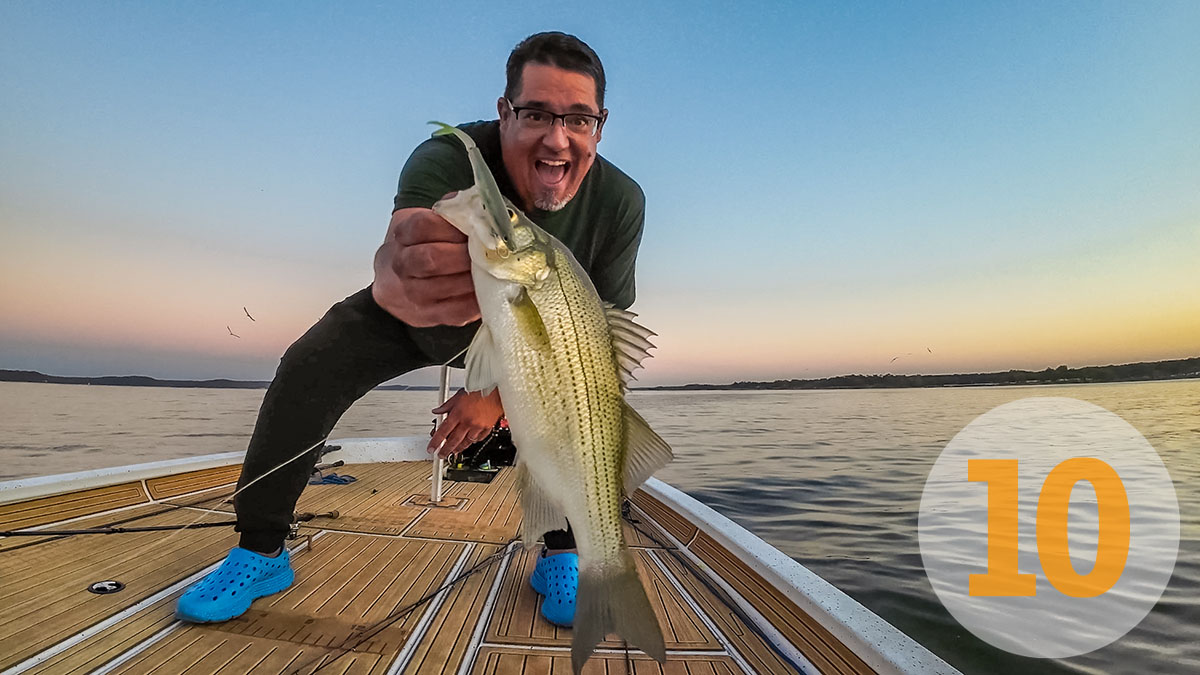
October Fishing
Fishing starts picking back up in October as the lake reaches winter pool and the water cools down significantly. These are signs for the fish to migrate back into the bays. And an abundance of shad in the lake means a lot more schools of fish will chase shad on the surface.
BEST BITE: This is prime time “jumps activity” for schools of white bass and stripers. The jumps are what locals call schools of white bass and other fish attacking giant balls of shad on the surface. Look for lots of birds circling or in a small area together. That is usually sign that fish are moving bait to the surface and in the area.
A 1/4 ounce lipless crankbait, small topwater and small jerkbait can be dynamite for schooling white bass this time of year. If you see a lot of splashes in an area, get there quick and cast around the splashes for fast and furious action.
OTHER GOOD BITES: Crappie start moving back into the bays. And you will find schools of crappie grouping up on the deeper brush coming towards and just inside of the bays in October. Vertical jigging, casting jigs and spider rigging can all be good in October.

November Fishing
November is one of the best months of fishing on Kentucky Lake. There are a lot less anglers on the lake in November, and the fishing action can be very good and very consistent. As the water temps get into the 50s a lot of fish like crappie and bass are in the bays feeding up for winter. You will find big groups of fish grouped up together and biting this time of year.
BEST BITE: This is one of the best times to crappie fish. There are less anglers than in the spring and the schools are often a lot bigger. Black crappie will school up and herd bait this time of year and can make for fast and furious action. Target mid depth cover to shallow cover, shaded areas, channel swing banks. Low light hours can be a lot better too. So early and late can be really good fishing for crappie.
OTHER GOOD BITES: Bass fishing gets really good in November as well. The bass will group up in deep swings and congregate to feed on shad. You can find schools of fish in deep channel swings, just off of deep ledges and where you find groups of deep bait in the bays. A blade bait, lipless crankbait and swimbait can be good as can an Alabama rig and a jerkbait. Spend time looking for deep bait and groups of fish to be rewarded with some great days.
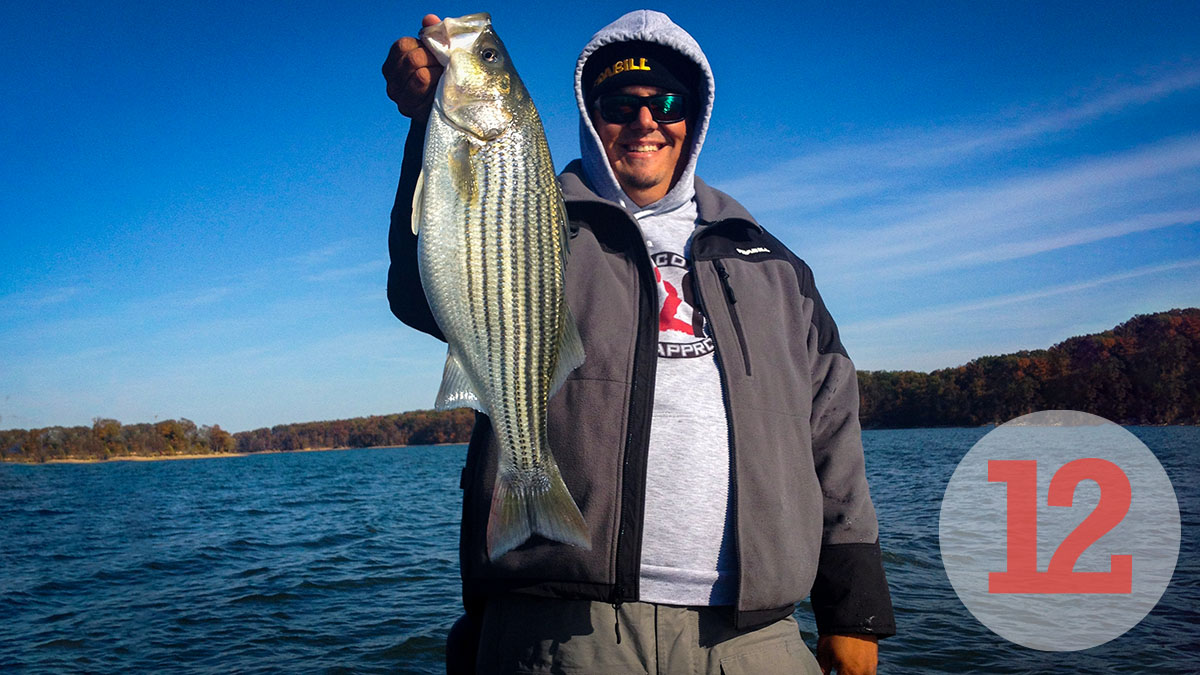
December Fishing
As the water cools, fishing slows down but usually it just means you change to slower techniques.
BEST BITE: December is when we see a lot of big stripers showing up and feeding. You can catch these fish on deep channel swings and ledges and other deep transition areas. An Alabama rig as well as a single swimbait will catch big stripers on these deep points and banks as well.
OTHER GOOD BITES: December can still be very good crappie fishing on deeper brush and for roaming fish. Bass fishing is still usually really good with deep jerk baits and swimbaits fished on deep banks, deeper points and on ledges near the main river or mouths of the bays.
More About Kentucky and Barkley Lakes
After a devastating flood hit the area in 1937 causing many homeowners to be displaced, the TVA began construction of the hydroelectric dam in 1938. The dam was completed in 1944 and President Harry S. Truman dedicated the dam in 1945.
Kentucky Lake is now the largest man-made reservoir east of the Mississippi with more than 2,000 miles of shoreline and 160,000 acres of water — making it one of the most incredible water resources in the country. It not only manages flood control for the Tennessee and Ohio River valleys but it also generates electricity for the area. As equally important, it has become a proven and popular angling destination because of not only the numbers of fish but the size of those fish and provides a massive economic boost to the region through tourism.
Similarly Lake Barkley, named for the 35th Vice President Alben Barkley, began construction on the dam in 1959 and finished the project in 1966. Barkley is the much smaller of the two and a lot shallower as well. At about the third of Kentucky Lake’s size at 58,000 acres, it offers a lot more shallow water and true river fishing.

